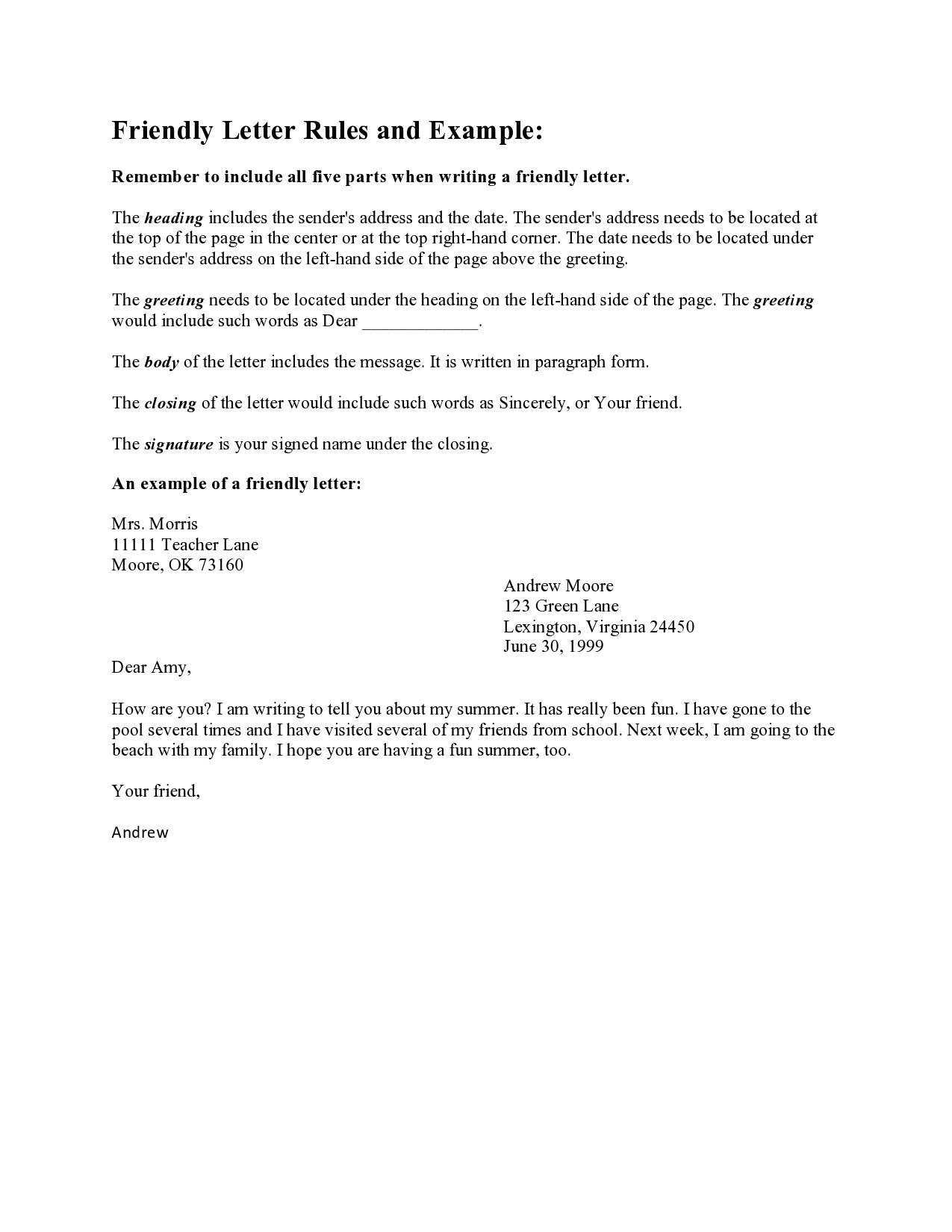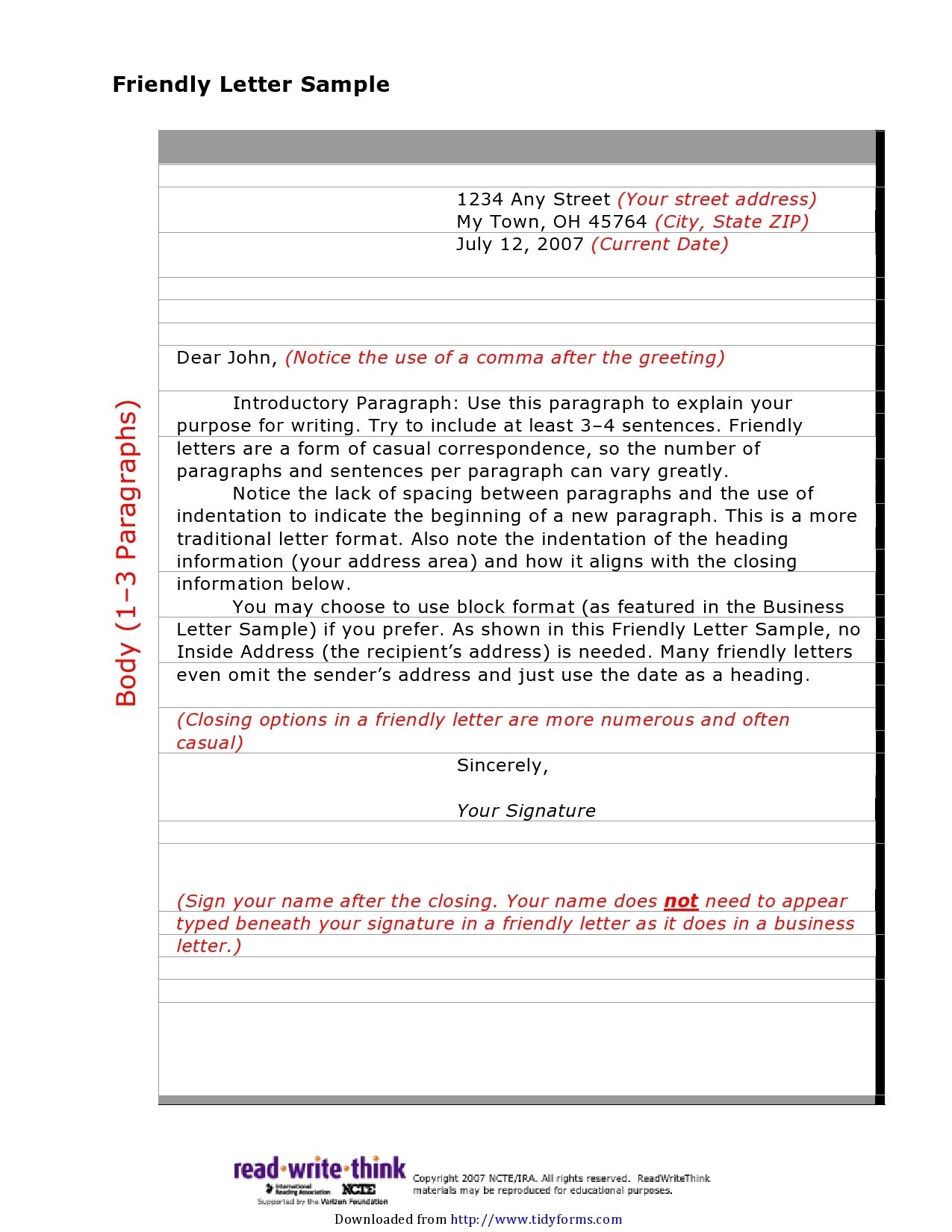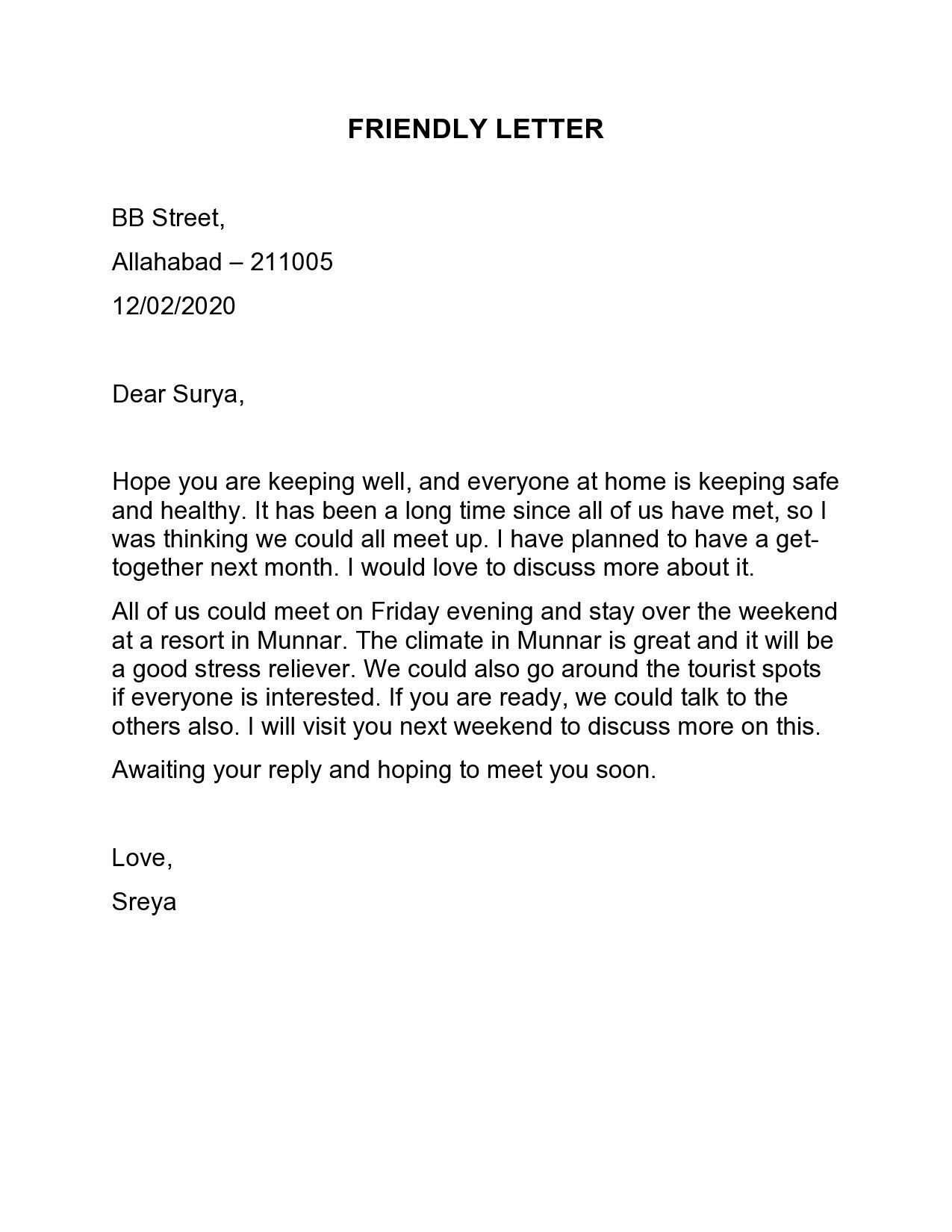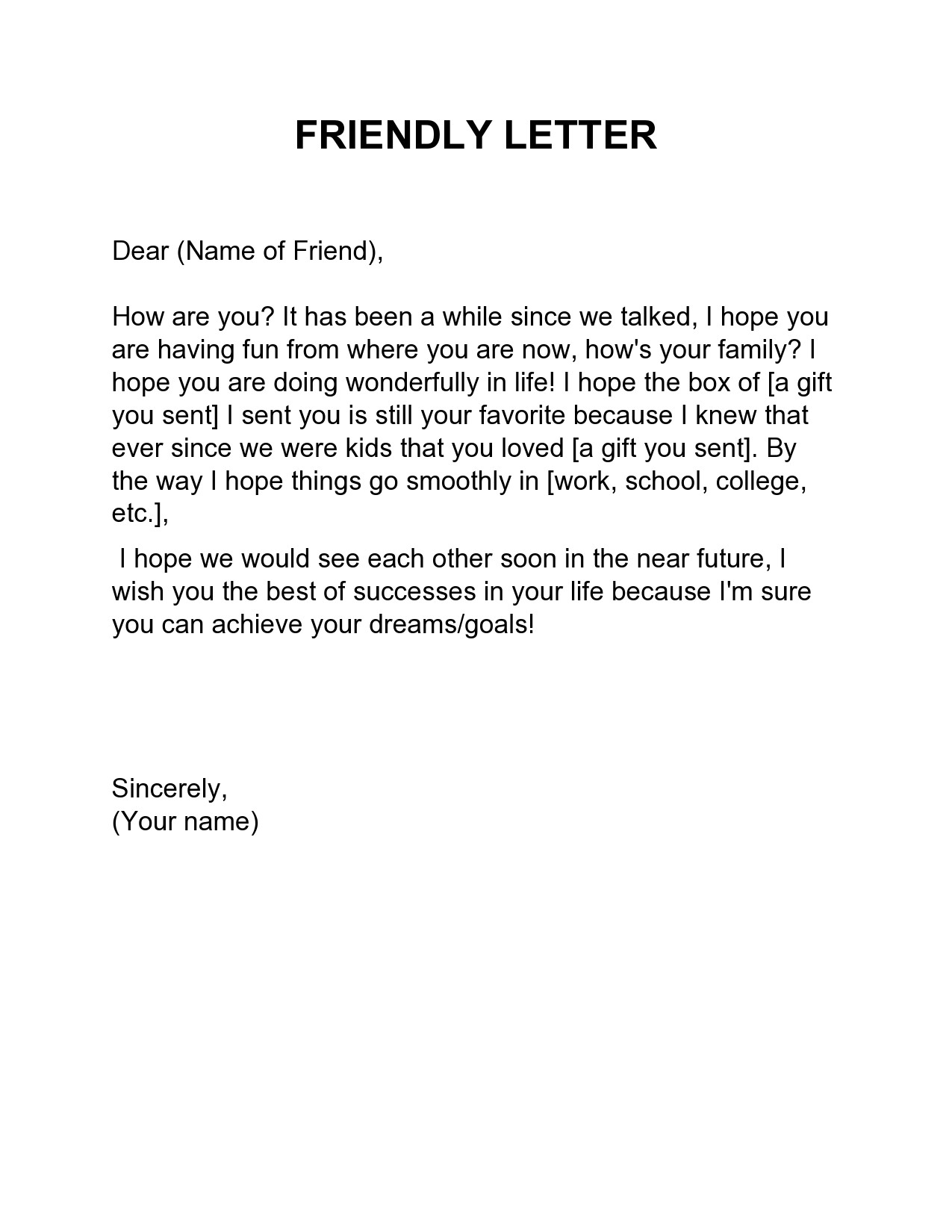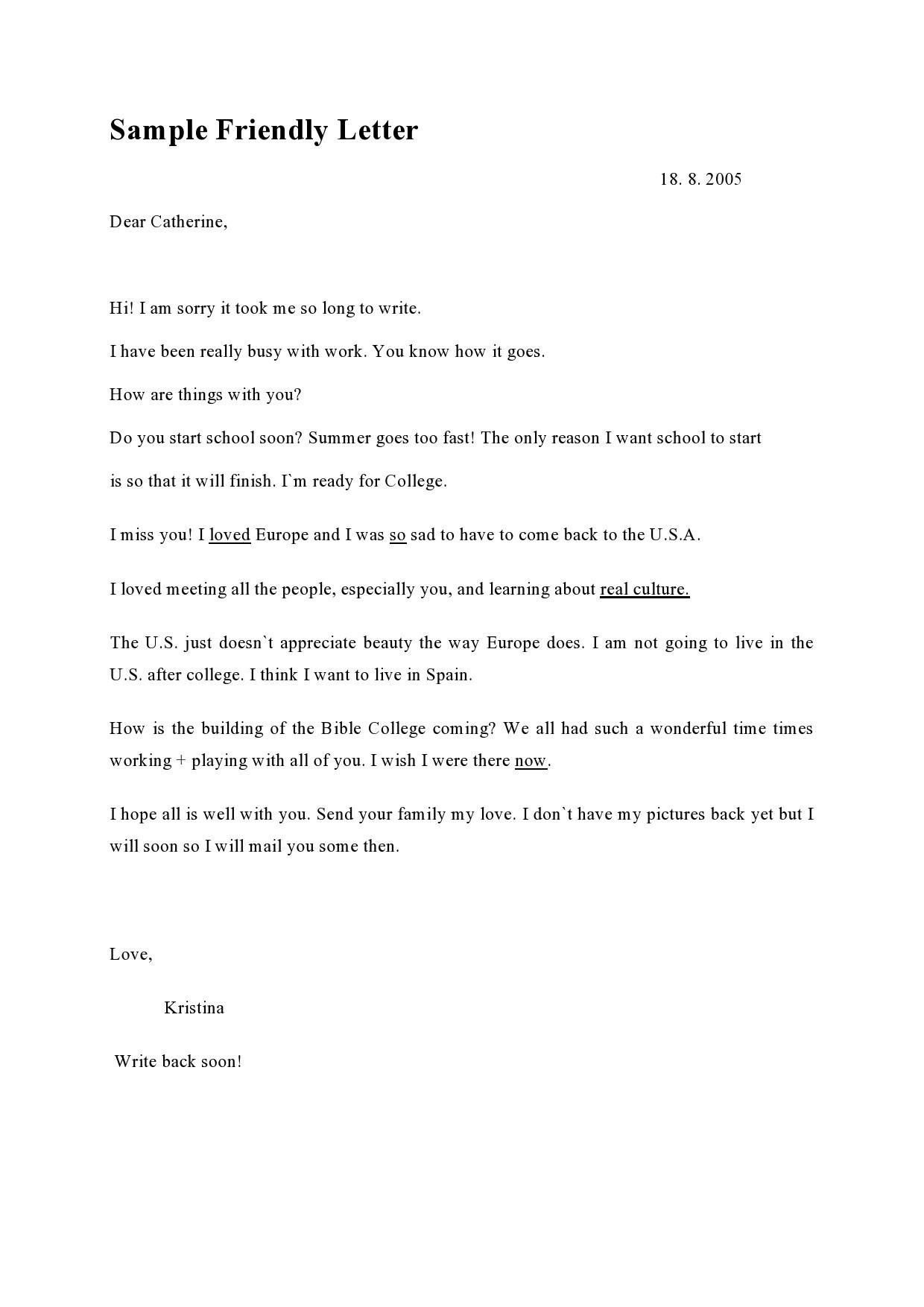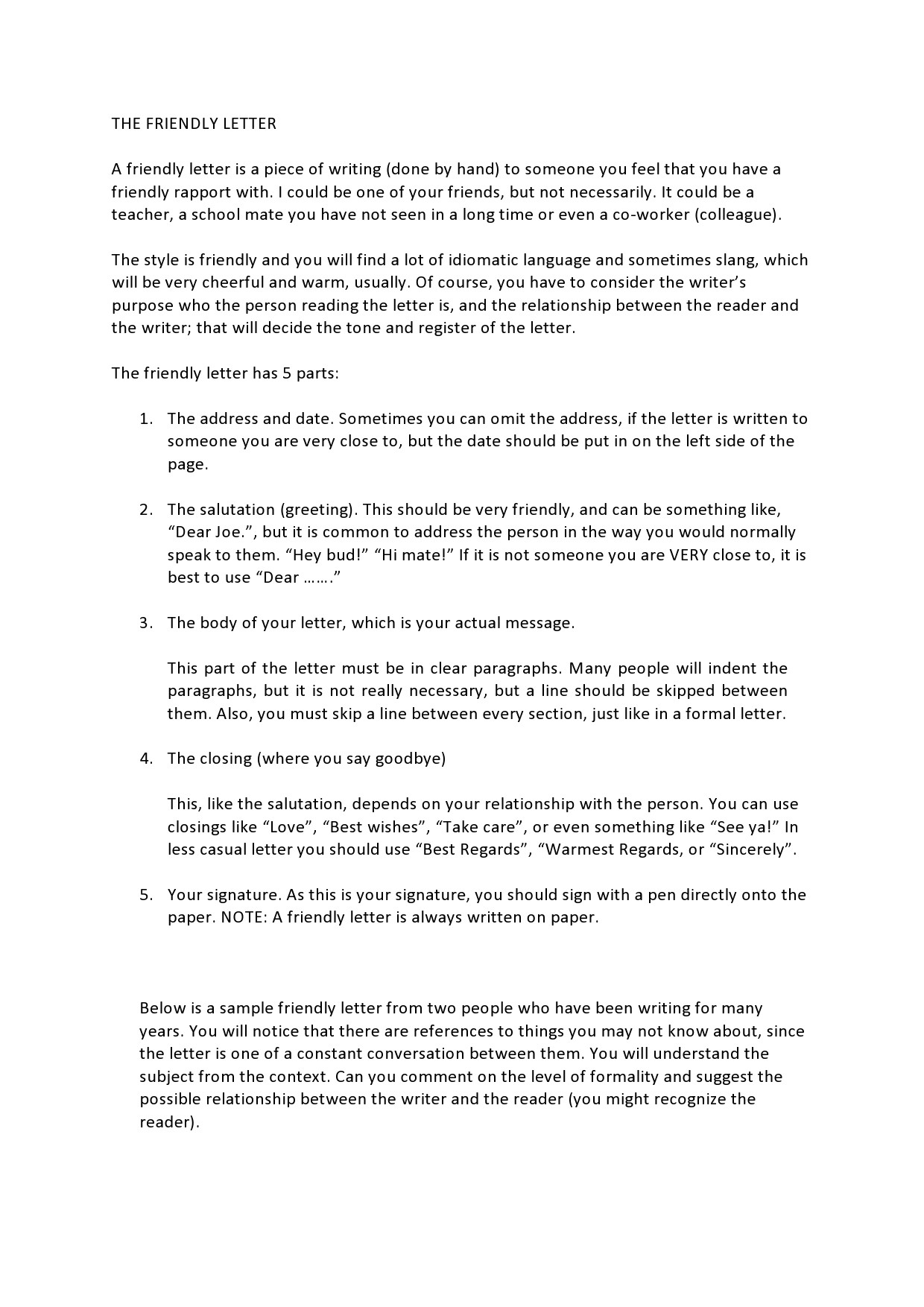Many people choose to send friendly letters using formats that are readily available online. Instant messages and emails are even more common. While these methods are both convenient and easy, they lack a personal touch. You would feel better if the contents of your letters came from your own words instead of someone else’s sample friendly letters. Communicating in this traditional way tends will make you feel more sincere. It will also send your recipients your true intentions. Writing a friendly letter will show that you really care since you have gone through the trouble of writing the letter.
Table of Contents
Friendly Letter Formats
What is a friendly letter?
A friendly letter is a letter you write to your friends, relatives, peers, acquaintances, or anyone you know. The recipient doesn’t necessarily have to be a friend, just anyone you feel friendly toward. Friendly letters aren’t considered as formal written documents since there are no standard rules for writing or following the format of a friendly letter. Moreover, there really isn’t any solid reason why you would write this letter to a friend.
You might just want to say “Hello,” talk about different things, or share fond memories. Generally, you would write a friendly letter with the purpose of conveying a specific message. It is a means of communicating with the people in your life and keep touch with them. It can even serve as a “socializing agent” where you confess something, share secrets, get opinions, and more.
Friendly Letter Examples
What to include?
Writing your own friendly letter example instead of sending an instant message or an email gives a more personal touch. When writing this letter, you should think about the contents. A typical letter includes the following:
- Address. You should include your return address and the date when you wrote the letter.
- Opening salutation. Include an opening salutation that’s appropriate to your closeness to the recipient of your letter.
- Body. This part will contain the contents of your letter. It can be as short as a couple of paragraphs or as long as several pages. You can make it as long or short as you want.
- Closing salutation. This is where you would say goodbye. Again, your closing salutation would depend on how close you are to the recipient.
- Signature. Assuming that you will write a friendly letter for someone who knows you quite well, you can sign your first name or use your nickname.
A traditional friendly letter would be hand-written, then sent through post. Although this means that it will take a longer time for the letter to reach the recipient, it is highly recommended if you want your letter to have a personal touch. But with the advent of technology, friendly letters usually come in typed form, then sent through email. This is also acceptable but not as personal.
How to format a friendly letter?
When writing this letter, remember that it’s different from other forms in both format and content. For instance, this letter has a casual purpose, it won’t provide as much identifying information compared to business letters. However, even if you use a casual tone, you would like it to have the right format. Here are some tips for this:
- Heading. The recipient of your letter might like to write you back. Providing your address in the heading will make this easier for them. Like any other part of your letter, you should include specific content and spacing requirements. The heading should be in the upper-left-hand corner of your letter. Include your street address, your state, city, zip code, and the date when you wrote the letter.
- Salutation. This is where you would greet the recipient. Often, a simple “Hello” would do. Make sure to align the salutation to the left margin, capitalize the first letter of the greeting and the name, and add a comma after the last word. After this, skip 2 lines.
- Body. This is where you would communicate the information you want to convey. Organize the information into paragraphs to help your recipient understand your thoughts. Align this text to the left too. You may or may not indent the first word of each paragraph if you want. Asking about the recipient’s health or their current activities first is a good idea to show that you want to reconnect with them. Then you can state the purpose of your letter along with other relevant details. The last sentence should end with a statement of well wishes or hopes for a reply.
- Closing and signature. After the body, skip 2 lines. Indent the line to align with the heading. Then you can say goodbye to your recipient. Write your closing sentiment using a capital letter, then end it using a comma. Directly below your closing sentiment, add your signature.
Sample Friendly Letters
How to write a friendly letter format?
With today’s modern technology, most people send text messages or private messages on social media when they want to connect with friends. Of course, doing this is much that is an easy and practical way to do it but nothing beats a good, old-fashioned friendly letter. Here are some tips for writing this letter:
- Start your letter
If you will write the letter by hand, it would be nice to include a date on the top-left corner of your paper. There are many people who want to save their correspondence as mementos. With a date, the recipient of your letter can see the day and year they received it. This little piece of information will allow them to reminisce about earlier days. You can either write the date completely or abbreviate it by only using numbers that indicate the day, month, and year.
Whether you will write the letter by hand or type it on your computer, then print it out, you will always start with a salutation. This is the line where you would address the person to whom you’re writing your letter. The salutation to use will depend on the nature of your relationship with the recipient and your own style and preference too. Choose the greeting accordingly and make sure that it ends with a comma. After this line, you can start writing the body of your letter.
- Convey your message
It is always a good idea to begin the body of your friendly letter with pleasantries to give a lighthearted and warm feel. Doing this is also a good way to set the tone of your letter as it will give the recipient an idea of what the letter would contain. It shows that your letter is a friendly one rather than a formal or serious one.
Extend your warm greetings in the first lines of your letter. You could even share a joke or talk about a good memory. These are some common letter openings. You can think of this part as the opening small talk or a prelude to a more meaningful conversation.
The next part of your letter will contain the main content and the purpose of why you wrote it. Here, you could be as articulate, straightforward, and open as you want so that you can convey your message effectively. Write something about your life and no matter what this is, the recipient will probably appreciate your letter and feel much closer to you, especially if you share revealing information.
Relate to your friend, any events that have happened in your life, the emotions you went through when those events occurred, and any plans you have for the future. Of course, you don’t have to overdo it, Just try to portray your life realistically. Also, you should only share details you feel comfortable with.
It’s also a good idea to share topics that are relevant to your recipient. Include in your letter references relevant to your purpose too. You can ask questions to show you have an interest in the recipient’s life.
Discuss subjects that are of mutual interest like current events, politics, arts, or any other topic that you have already discussed with them in person. You can even suggest movies that you have watched or books that you have read that you think the recipient might appreciate. Sharing good information is a common and welcome tradition among friends.
- Close your letter
When you’re done with the main message, it’s time to wrap things up. The last paragraph of your letter should contain words of best wishes for the recipient. This part usually has a lighter tone compared to the body although it should still match the general feel of the letter. Try looking for the right words that will leave your recipient with positive feelings and thoughts. You can also mention the purpose of your letter again and encourage your recipient to write back.
When it’s time to write the closing, make sure to choose words that are in sync with the rest of your letter, whether you have written it using a casual or traditional tone. Just like your salutation, your closing will depend on your relationship with the recipient. After this, sign your whole name or nickname.
While not required, you may include a postscript. You would include a postscript or PS at the end of a friendly letter if you want. This is a great way to add more information that isn’t as relevant as the rest of the content in the body of your letter. You could include a joke, a note, or just leave this part out. If you do add a PS, make sure it matches the rest of your letter’s tone.
Formats Of A Friendly Letter
Mistakes to avoid
Although these letters don’t have any strict requirements or rules, you still want to write them well. Here are some common mistakes that you should avoid when writing a friendly letter:
- You don’t introduce yourself. This applies if you’re writing to someone you haven’t spoken to in a while. You may remember their name but they might not remember yours. If you aren’t sure if your recipient will remember you, remind them by adding some details about yourself and how you met.
- Not using the correct punctuation. Even the best writers can have issues like this. For instance, the simple placement of commas. Your recipient might not be an expert at writing, but they might still notice these small errors. Although they won’t blame or call you out for such, you still don’t want them to see such errors.
- Complaining too much. Even if your recipient isn’t a psychologist, you might want to share some sad or frustrating news. Just try not to focus on such details in your letter entirely. Just don’t hide any relevant information if it really matters.
- Making your letter too long. Remember that you’re writing a friendly letter, not a novel. A good letter should be no more than 3 pages in length. Your recipient might even appreciate a shorter letter as it will save them time. Also, try using shorter sentences to increase your letter’s readability.
- Not signing your name. A friendly letter isn’t a piece of formal writing. But it still has to follow the proper etiquette. For instance, you need to include a closing phrase and your signature. These are essential aspects of writing your letter, so you should always keep them in mind. When writing this letter, you may use informal language.
- Not proofreading your letter before you send it. Remember that when you write this letter, the intent isn’t to get a high score. But this doesn’t mean that you should ignore the basic grammar rules. With today’s messaging conveniences, getting a hand-written friendly letter is a wonderful surprise. Try to make this the perfect surprise for your friend.
- Not using proper divisions for your paragraphs. Although a friendly letter isn’t a piece of academic writing, you should still make it readable for the comfort and convenience of your recipient. Make sure that you start each new paragraph for new topics. For instance, your first paragraph could contain an explanation of why you wrote the letter. The next paragraph will contain your news. Keep going until you reach the end of your letter.









